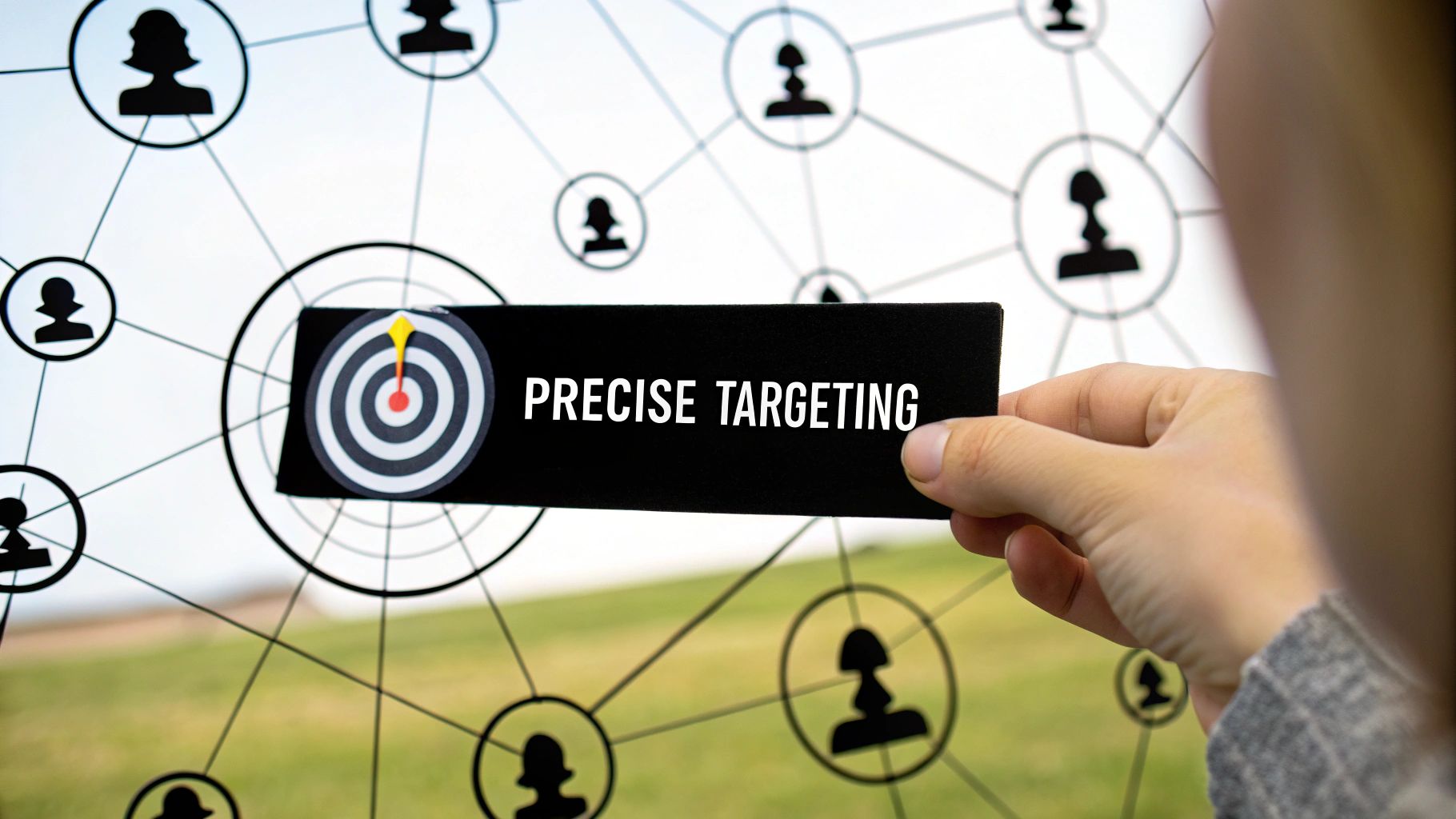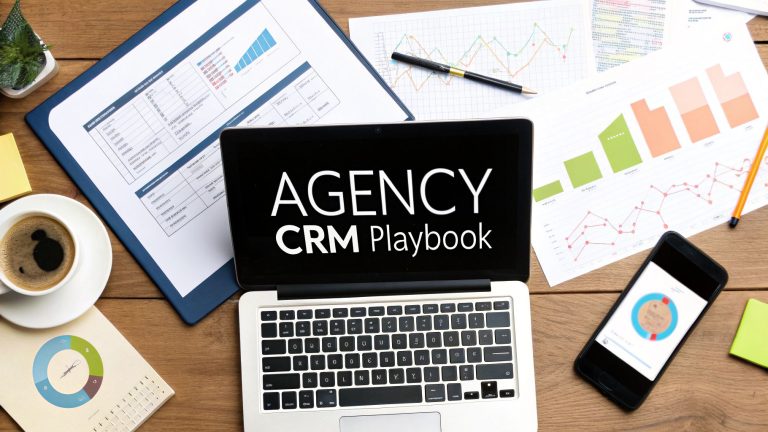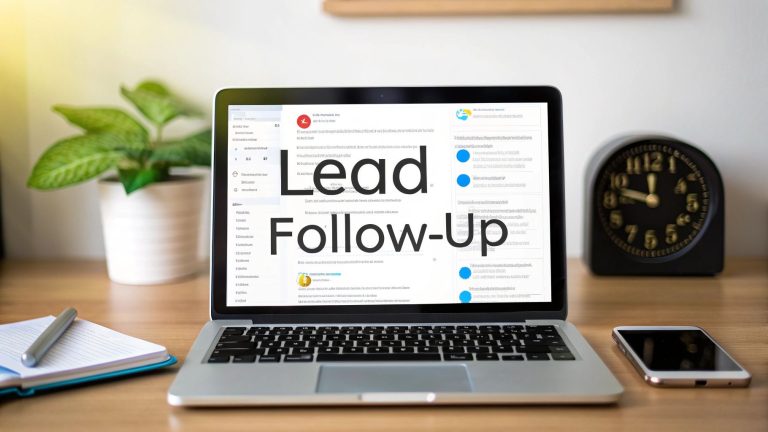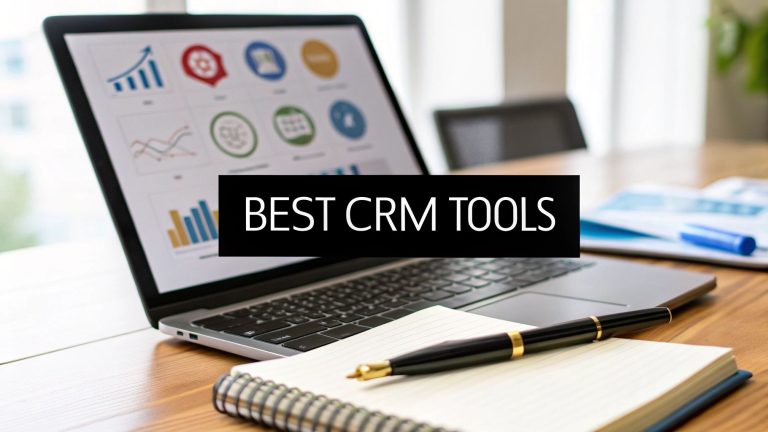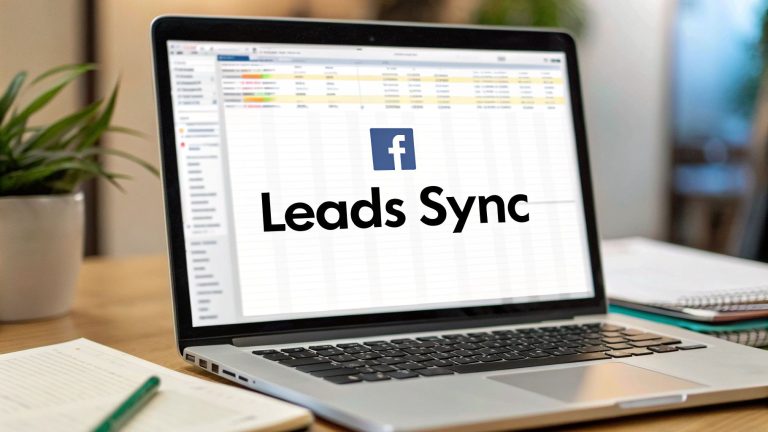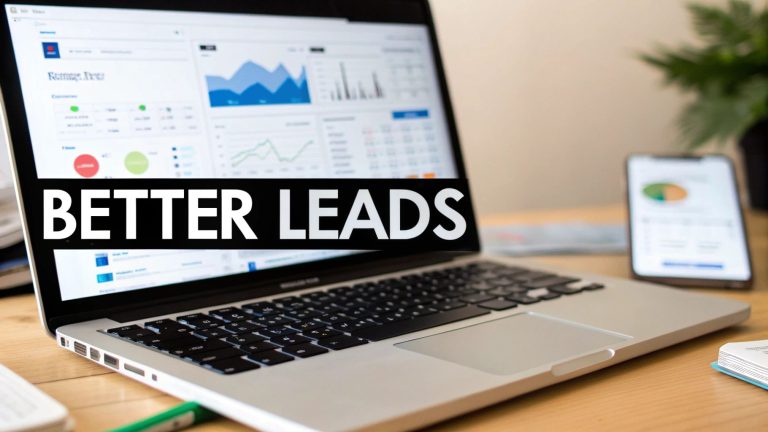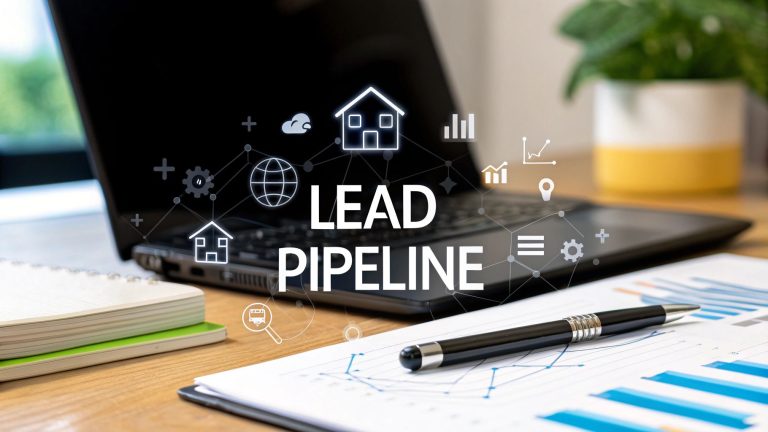A Guide to Facebook Ads Targeting Options
If you're spending money on Facebook ads and not getting results, I can almost guarantee your targeting is off. It's the single biggest mistake I see businesses make. Pouring ad spend into a campaign aimed at the wrong people is like shouting into the void—your message, no matter how brilliant, just won't land.
The key to unlocking real growth on Facebook isn't about having the biggest budget; it's about reaching the right people. Luckily, the platform gives us three incredibly powerful tools to do just that: Core Audiences, Custom Audiences, and Lookalike Audiences.
Getting a handle on these three options is what separates the advertisers who are just guessing from those who are building a predictable pipeline of customers.
Why Precise Targeting Is Your Greatest Advantage
Running ads with vague targeting is a "spray and pray" approach. You’re essentially throwing money at the wall and hoping something sticks. It’s expensive, inefficient, and demoralizing.
Precise targeting flips that script. It turns your ad spend into a surgical tool, ensuring every dollar is invested in reaching users who have a genuine interest in what you’re selling. This is how you move from random clicks to a calculated growth strategy.
With over 3 billion people on the platform, Facebook's potential reach is staggering. But success isn't about reaching everyone. It's about reaching the right someone. Facebook lets you get incredibly specific based on demographics, what people are interested in, their online behaviors, and even how they've interacted with your business before.
To make this manageable, Facebook organizes targeting into three distinct pillars. Each one serves a different purpose and is designed for a different stage of your marketing funnel, from grabbing the attention of new people to sealing the deal with warm leads.
This diagram breaks down how these three core audience types are the foundation of any smart targeting strategy.
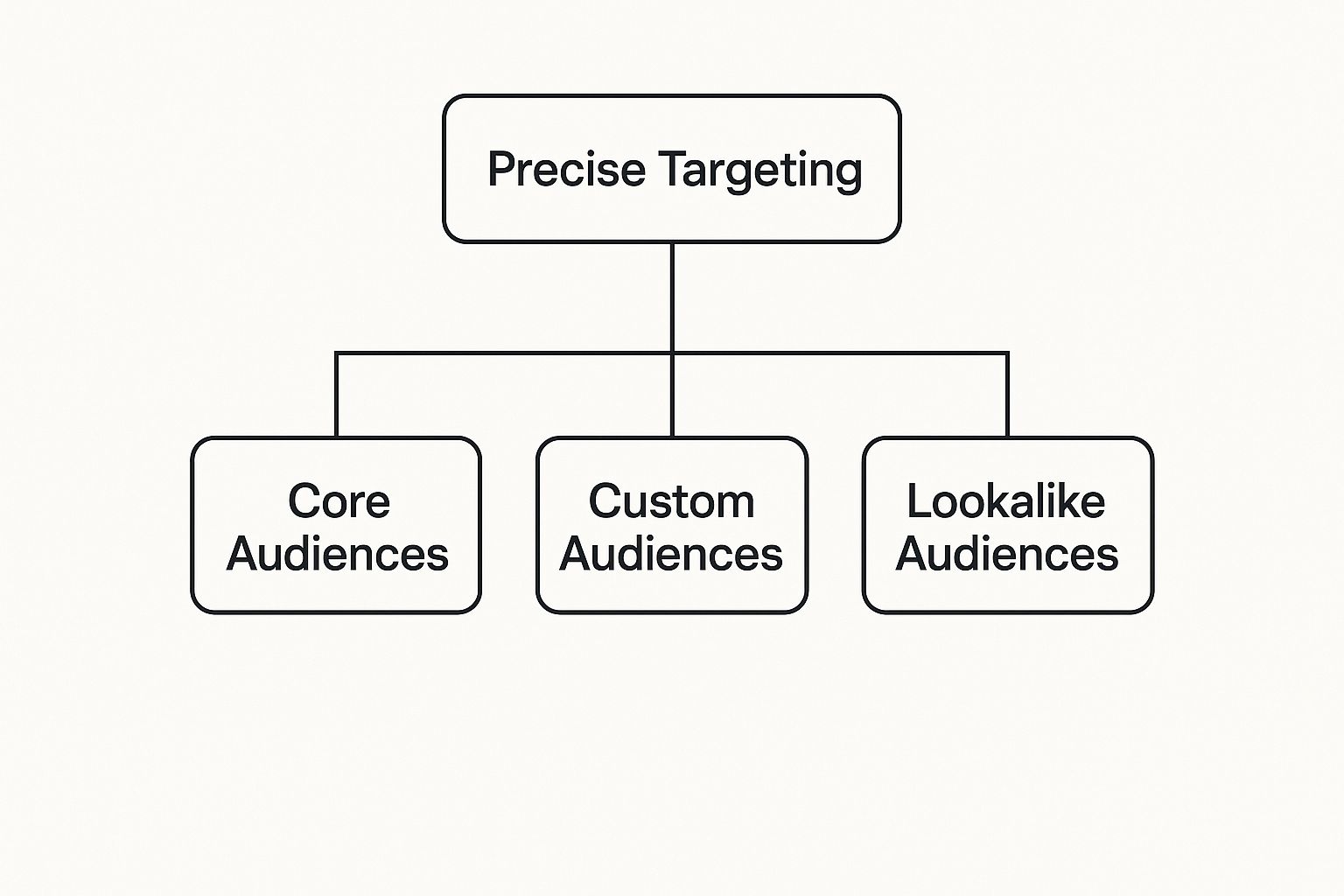
As you can see, every effective ad campaign starts with a choice between these fundamental categories. Each one is a tool built for a specific job in the customer journey.
To make it even clearer, let's quickly summarize how these three pillars work together.
The Three Pillars of Facebook Ad Targeting
| Audience Type | Primary Use Case | Best For |
|---|---|---|
| Core Audiences | Finding new customers who don't know you yet. | Top-of-funnel awareness and lead generation. |
| Custom Audiences | Re-engaging people who have already interacted with you. | Middle/bottom-of-funnel nurturing and conversions. |
| Lookalike Audiences | Scaling your campaigns by finding new people similar to your best customers. | Finding high-quality new customers efficiently. |
Think of these audience types as strategic assets. Each one plays a critical role in building a full-funnel advertising machine that not only brings in new customers but keeps them coming back.
-
Core Audiences: This is your starting point for discovery. You’re telling Facebook, "Find me people who live here, are this age, and are interested in these things." It's perfect for getting your brand in front of fresh eyes.
-
Custom Audiences: This is where the real magic happens. You’re targeting your warmest leads—people who have visited your website, signed up for your newsletter, or engaged with your page. These are your highest-value targets for conversions.
-
Lookalike Audiences: This is your engine for growth. You give Facebook a list of your best customers (a Custom Audience), and its algorithm goes out and finds millions of new people who share similar traits. It's the fastest way to scale what's already working.
When you master these three pillars, you stop just "running ads" and start architecting a predictable system for acquiring customers. It's all about getting the right message to the right person at the perfect time.
Building Your Foundation with Core Audiences
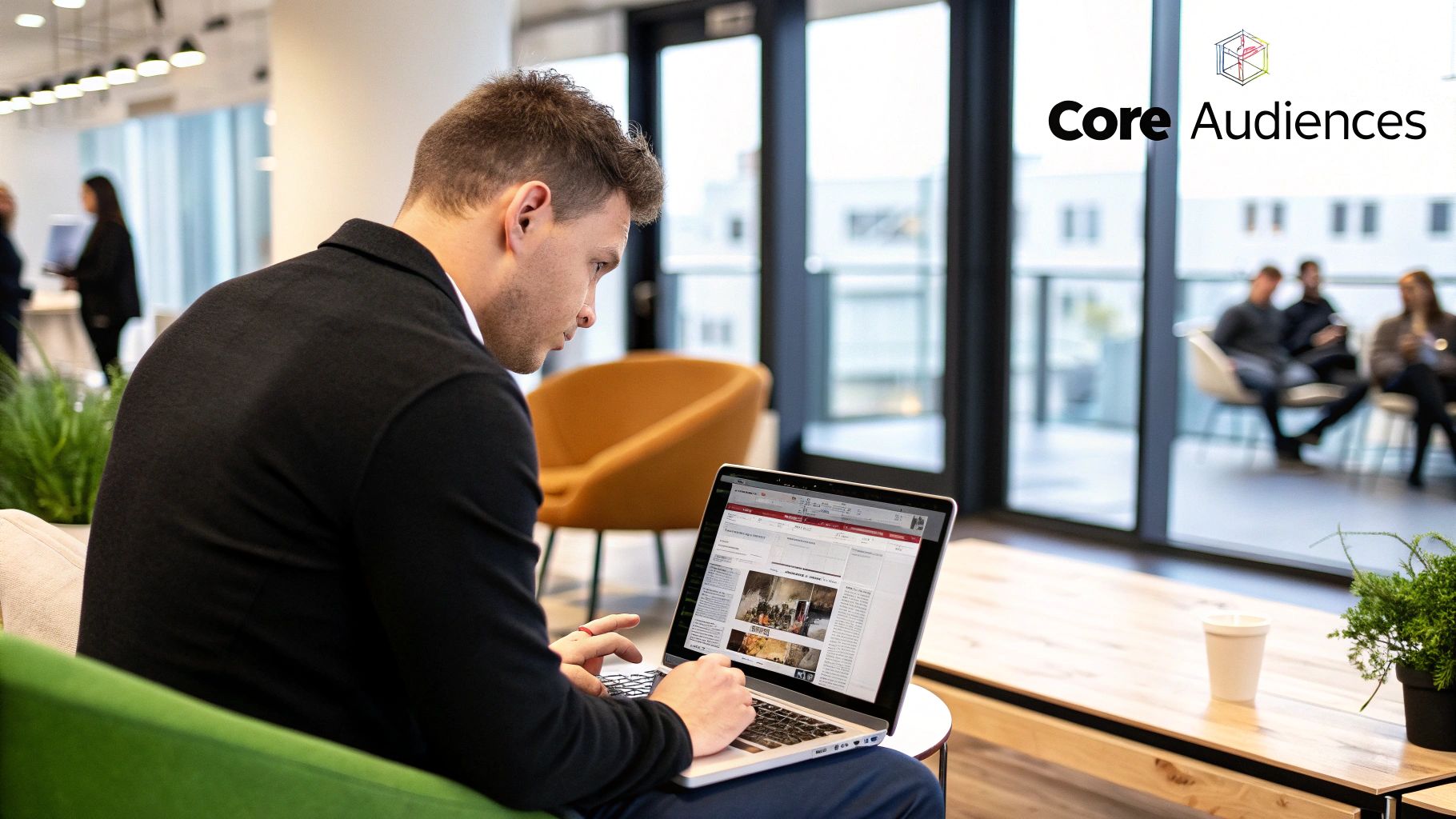
If you're starting a new campaign from scratch, Core Audiences are your bread and butter. Think of them as the raw clay you get to mold. This is where you take that picture of your ideal customer you have in your head and build them, piece by piece, from Facebook's massive user base.
You're essentially telling Facebook, "Go find me people who look like this." These audiences are built by hand-picking different traits, interests, and behaviors that users have shared on the platform. It might seem like a lot of options at first, but getting this right is the key to reaching brand-new customers who have never heard of you.
If you want a full walkthrough of the Ads Manager dashboard itself, our complete Facebook Ads Manager tutorial will get you up to speed on setting up your first campaign.
The real power of Core Audiences comes from layering four main types of targeting. Let's dig into each one.
Location Targeting
This one seems simple, but don't underestimate its power. You can target people based on where they are right now, where they live, or where they've been. You can go as broad as an entire country or as laser-focused as a one-mile radius around your front door.
This is a game-changer for local businesses. A coffee shop, for example, can run a 10% off coupon targeting everyone within a one-mile radius between 7 AM and 9 AM. It's direct, timely, and incredibly effective for driving foot traffic.
You can also get more specific:
- People living in or recently in this location: This is the broadest net, catching both residents and recent visitors.
- People living in this location: Perfect for businesses that serve local residents only, like a dentist's office.
- People recently in this location: Great for targeting tourists who just passed through and might be looking for souvenirs or local experiences.
- People traveling in this location: This option specifically finds people whose home is over 125 miles away—a goldmine for hotels, tour companies, and attractions.
Demographic Targeting
Demographics are the hard facts about your audience—things like age, gender, education, and relationship status. But it goes way deeper than that. This is where you can pinpoint people based on major life moments or professional milestones.
Some of the most valuable demographic filters include:
- Education: Target by degree, field of study, or even specific universities.
- Financial: While direct income targeting is limited, you can still reach people in certain household income brackets in some areas.
- Life Events: This is where the magic happens. You can find people who are newly engaged, just moved into a new home, have an anniversary coming up, or are celebrating a birthday next week.
- Work: Need to reach a specific professional? Target users by their industry, employer, or even job title. A B2B company could target "Chief Financial Officers" at tech companies.
These details help you show up with the perfect offer at the exact moment someone needs it most.
Interest Targeting
This is all about what people love. Facebook builds these audiences based on the pages people like, the posts they engage with, and the ads they click on. It's your direct window into their hobbies, passions, and shopping habits.
Key Insight: Don't just target the obvious. If you sell premium running shoes, don't stop at the "running" interest. Think bigger. Target interests like "Marathon training," magazines like "Runner's World," and even brands like "Garmin" or "Strava."
This strategy helps you find the true enthusiasts in your niche—the people who live and breathe the lifestyle around your product, not just casual observers.
Behavioral Targeting
While interests are about what people like, behaviors are about what people do. This data is based on real-world actions, both on and off Facebook, like their purchase history, device usage, or travel patterns.
Here are a few powerful examples:
- Purchase Behavior: Find people who are known "Engaged Shoppers"—users who frequently click the "Shop Now" button on ads.
- Digital Activities: You can target people based on the type of phone they use (like iPhone 15 users) or whether they are early adopters of new technology.
- Travel: Reach frequent flyers, business travelers, or people who regularly commute.
The real skill is in combining these layers. A local jewelry store could target people who live within a 10-mile radius (Location), are "Newly Engaged" (Demographic), and are also "Engaged Shoppers" (Behavior).
That level of precision ensures your ad for custom engagement rings isn't just shouting into the void. It’s reaching the perfect person, in the right place, at the right time, dramatically boosting your odds of making a sale.
Driving Conversions with Custom Audiences
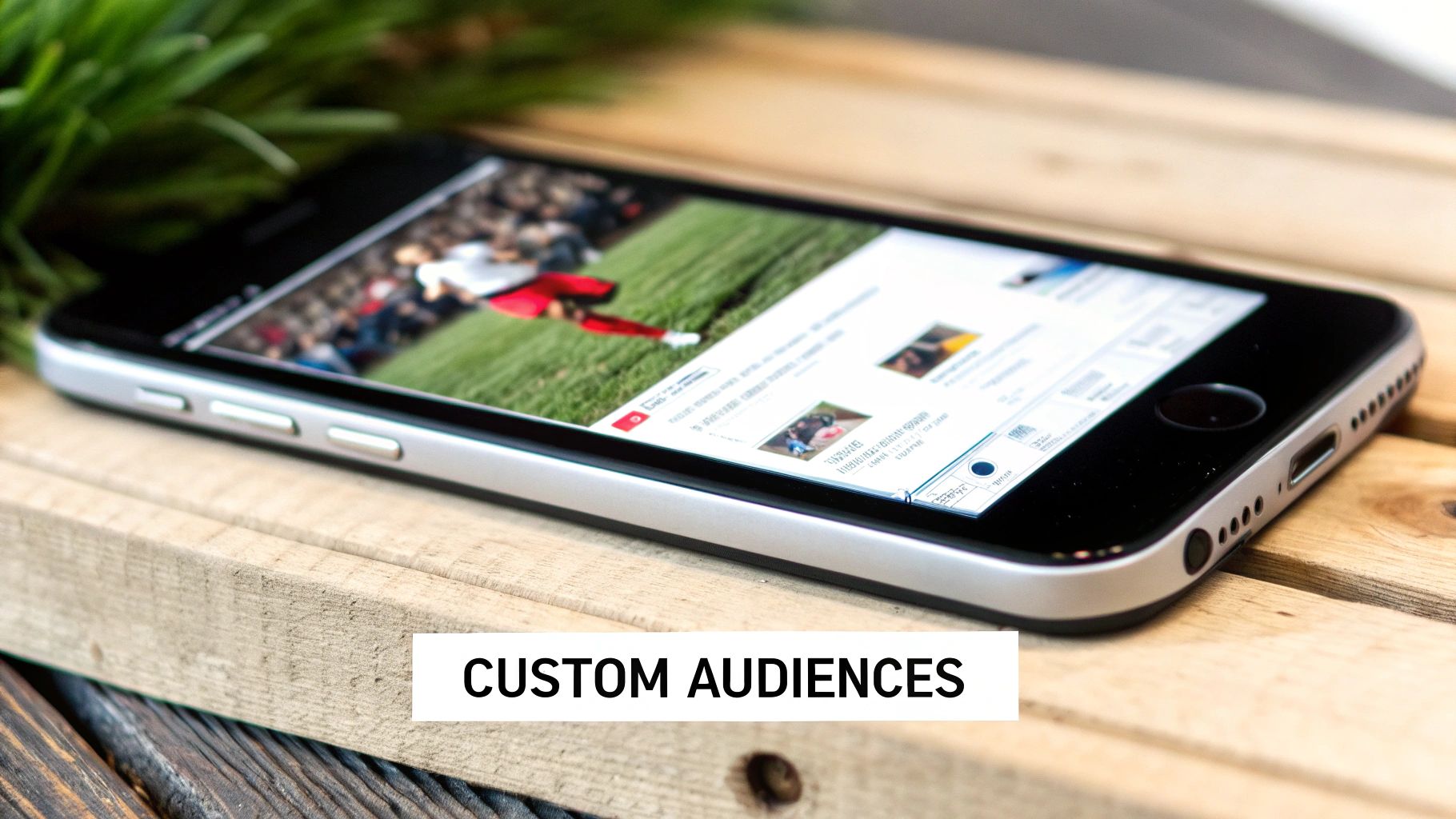
If Core Audiences are about finding new people, Custom Audiences are all about turning existing interest into paying customers. This is where your ad spend gets incredibly efficient because you’re focusing on people who already know your brand.
Think of it like this: using Core Audiences is like walking into a crowded party and introducing yourself to strangers. Using Custom Audiences is like striking up another conversation with someone you’ve already met. Which one do you think is more likely to end well?
These audiences are built from your own data—people who’ve already interacted with you. They’re a warm audience, and they’re way more likely to convert because you’ve already broken the ice.
The Power of Your Own Data
The secret to a killer Custom Audience is clean, accurate data. You can pull from a few different sources to reconnect with potential customers, delivering just the right message based on what they’ve already done.
Here are the most common (and effective) types you can create:
- Website Visitors: Using the Meta Pixel, you can group people who visited your site, looked at specific products, or even added something to their cart.
- Customer List: Got a list of emails or phone numbers? You can upload it, and Facebook will securely match that data to user profiles.
- App Activity: If you have an app, you can target users based on actions they took inside it, like beating a level or making a purchase.
- Engagement: This one is huge. It lets you build audiences from people who engaged with your content right on Facebook or Instagram—like video viewers or profile visitors.
By retargeting warm traffic, you are essentially continuing a conversation that has already started. This group has demonstrated interest, and your job is to guide them toward the next logical step with a relevant ad.
For example, someone who abandoned their shopping cart doesn't need a "Who We Are" ad. They need a gentle nudge. Show them an ad with a great customer review or a limited-time free shipping offer to get them over the finish line.
Creating High-Impact Retargeting Campaigns
Just building the audience isn't enough; the magic is in the message. You have to match your ad creative to where the user is in their journey. A one-size-fits-all approach is a waste of money here.
Here’s a simple, practical way to structure your retargeting:
- General Website Visitors (Last 30 Days): These folks are familiar but might need more convincing. Show them ads that build trust, like customer testimonials or a behind-the-scenes video.
- Specific Product Page Viewers (Last 14 Days): This group is getting serious. Hit them with a dynamic ad showcasing the exact product they viewed. Remind them why it’s great.
- Cart Abandoners (Last 7 Days): This is your hottest audience. They were one click away from buying. Give them an offer they can’t refuse—a small discount code or a reminder about your easy return policy often does the trick.
The numbers don't lie. Even heading into 2025, Facebook's ad platform is a powerhouse. Its ad reach in the U.S. covered a massive 56.8% of the population. People are still clicking, averaging about 12 ad clicks per month, which proves that a relevant ad always wins. For e-commerce, the median ROI on Facebook ads hit 4.6x in Q1 2025.
Of course, none of this matters if you aren't tracking it correctly. To make sure you’re getting the full picture, check out our guide on setting up Facebook Ads conversion tracking.
Beyond Website Visitors
While website retargeting gets all the attention, don't sleep on on-platform engagement. You can create incredibly effective audiences of people who never even left the Meta ecosystem.
- Video Viewers: Someone who watched 50% or more of your video is clearly interested. Create an audience of these viewers and hit them with a follow-up ad that pushes them to take the next step.
- Instagram Profile Visitors: A profile visit is a strong signal of intent. Retarget these users with an ad featuring your best-selling products or your unique brand story.
- Lead Form Completions: Using Facebook Lead Ads? You can use a tool like LeadSavvy Pro to automatically sync your leads and retarget anyone who submitted their info but hasn't become a customer yet. Show them a case study or a special offer to seal the deal.
When you start combining these different Custom Audience types, you build a powerful system that catches interest at every single touchpoint, efficiently turning curious onlookers into loyal customers.
Scaling Your Reach with Lookalike Audiences
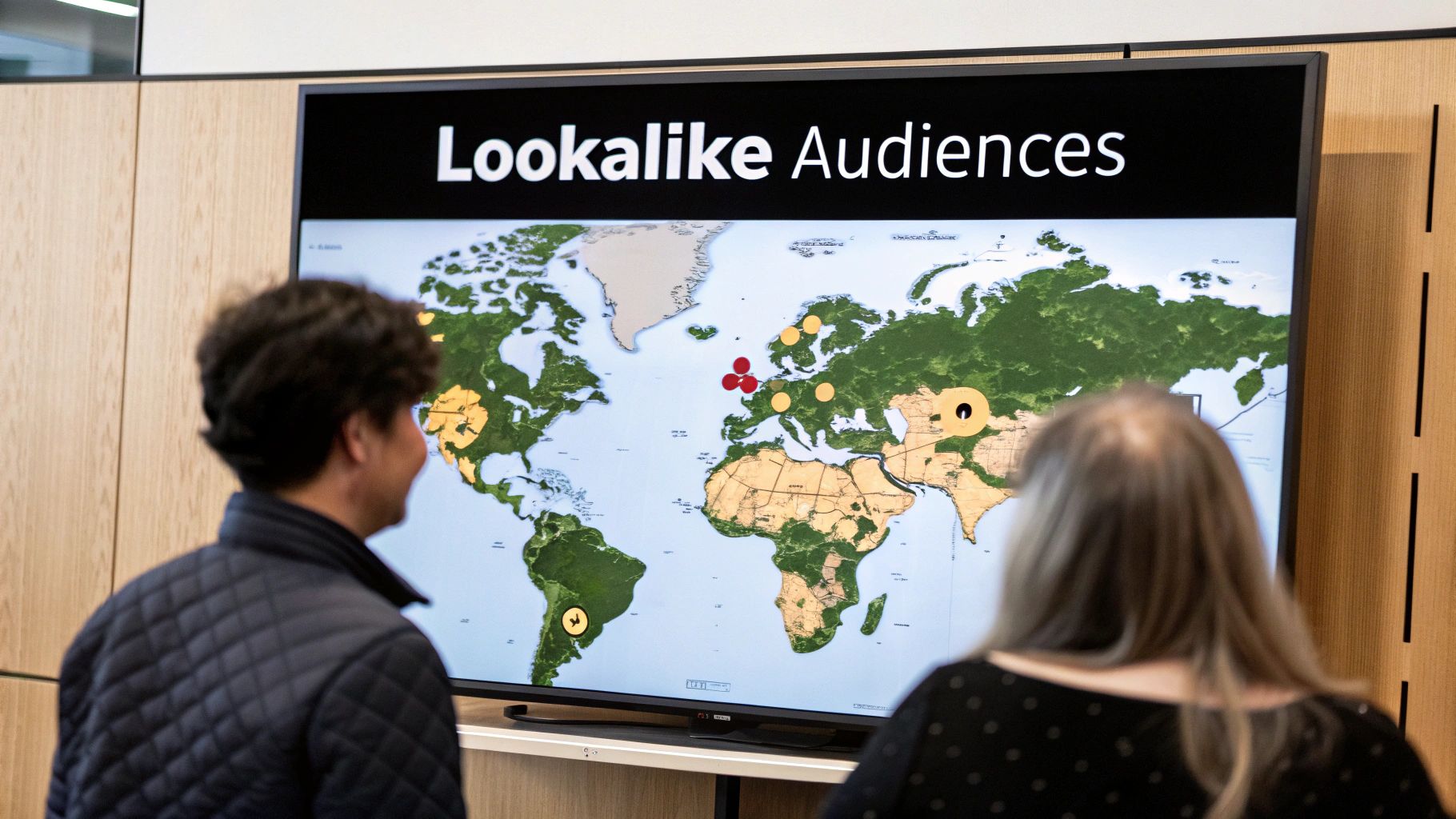
So you've built a solid customer base. Your retargeting campaigns are humming along, bringing in great returns. But the big question looms: how do you find your next 10,000 customers?
This is where Lookalike Audiences step in, becoming one of the most powerful tools in the entire Facebook Ads arsenal. They are the answer to the biggest challenge every growing business faces: how to scale up without lighting your budget on fire.
Think of it like cloning your best customers. It's the closest thing we have. You give Facebook a list of your most valuable people—this is called a "source audience"—and its algorithm gets to work, analyzing thousands of data points to figure out what makes them tick. Then, it goes out and finds millions of new people who "look" just like them online.
This whole process is a game-changer. It pulls the guesswork right out of prospecting. No more blindly picking interests and behaviors you think your audience might have. Instead, you're using real data from your actual, paying customers to guide Facebook’s ridiculously smart machine learning.
Choosing Your Source Audience
Let's be clear: the quality of your Lookalike Audience is 100% tied to the quality of your source audience. It's a classic case of garbage in, garbage out.
A powerful source audience needs two things: it has to be high-quality, and it needs to be big enough for the algorithm to spot meaningful patterns. You need at least 100 people, but the sweet spot is really between 1,000 to 5,000.
Here are some of the best sources you can use:
- A Customer List: This is the gold standard. Uploading a list of your past purchasers or high-LTV clients gives Facebook a crystal-clear picture of who you want more of.
- High-Intent Website Visitors: Don't just dump all your website traffic in there. Create a Custom Audience of people who actually completed a purchase, filled out a key form, or spent the most time on your site.
- High-Engagement Users: You can also build a source from people who are deeply engaged with your brand. Think about users who have watched 75% or more of your video ads or are constantly interacting with your Instagram page.
The trick is to pick a source that reflects the goal you're chasing. If you want more sales, use a list of your best customers. If you want more qualified leads, use a list of people who have already converted into leads.
A Lookalike Audience built from your top 10% of customers based on lifetime value will almost always demolish one built from your entire email list. Quality beats quantity, every single time.
Understanding Lookalike Percentages
When you set up a Lookalike, Facebook asks you to pick a percentage from 1% to 10%. This number isn't random. It represents the percentage of total users in your target country that most closely match your source audience.
- 1% Lookalike: This is your sniper rifle. It’s the smallest, most precise audience, targeting the top 1% of users who are a near-perfect match for your source. Always start here. It’s your highest-quality pool of new prospects.
- 1% to 3% Lookalike: This broadens your reach a bit while still keeping things highly relevant. It finds the top 1-3% of matching users but excludes the initial 1% you're already targeting.
- 3% to 10% Lookalike: Now you're casting a much wider net. As you push toward 10%, the audience becomes less similar to your original source, but your potential reach gets a massive boost.
A classic, winning strategy is to start with a 1% Lookalike. Let it run, get some data, and once it's performing well, you can start to scale. The next step is to launch a separate ad set targeting a 1-3% or 3-5% Lookalike. This lets you expand your reach methodically without sacrificing quality.
Advanced Lookalike Strategies
Once you've got the basics down, you can start getting creative by combining audience types for even sharper targeting. For example, you could take that high-performing 1% Lookalike of your best customers and layer it with an interest filter for a major competitor's brand. Boom—you’ve just narrowed an already premium audience down to an incredibly motivated segment.
Another slick move is to create multiple Lookalikes from different source audiences. You could build one from your highest AOV (Average Order Value) customers and another from your most frequent repeat buyers. Then, you can run them against each other in separate ad sets to see which customer profile unlocks the most profitable new audience.
This is especially powerful for businesses running Facebook Lead Ads. With LeadSavvy Pro, you can easily manage your incoming leads and export a clean list of only those who became paying customers. Using that list as your source creates a Lookalike Audience of people who aren't just likely to fill out a form—they're likely to hand you money. This closes the loop between lead gen and scalable growth perfectly.
Advanced Strategies for Maximum Impact
Okay, so you've got the building blocks down: Core, Custom, and Lookalike audiences. That's the foundation. Now it's time to start thinking like a professional media buyer and combine them.
These advanced strategies are where the magic happens. We're moving beyond single-audience campaigns and building a full-funnel machine—one that guides people from their first look at your brand all the way to the final purchase. It's not about picking just one of the Facebook Ads targeting options; it's about making them work together in harmony.
Layering Audiences for Precision
Think of audience layering as using a series of filters to get exactly who you want. You start with a promising but pretty large group, like a Lookalike Audience, and then you get more specific by adding extra rules. It’s the difference between casting a wide net and using a spear.
For instance, let's say you have a killer 1% Lookalike Audience built from your best customers. It’s already performing well, but you want to find the absolute cream of the crop within that group. You can layer on another filter:
- Behavioral Layer: Tell Facebook to only target people within that Lookalike who are also "Engaged Shoppers."
- Demographic Layer: Get even more granular by targeting only those with a specific job title or household income.
This is how you pinpoint the most valuable slice of a bigger audience. You stop wasting money on "maybe" prospects and focus your budget on users who are practically raising their hands to buy.
Structuring a Full-Funnel Targeting Strategy
A smart ad strategy doesn't shout the same message at everyone. It meets people where they are in their journey with your brand. By building a multi-campaign structure, you can use different audience types to talk to people at each stage of the marketing funnel.
This "full-funnel" approach is a game-changer for creating a reliable flow of customers. It lets you bring new people into your world while consistently converting those who are already familiar with you.
Here's a simple table to show how you can combine different audiences to target users at every stage of their journey.
Full-Funnel Targeting Strategy Example
| Funnel Stage | Audience Type | Example Target | Campaign Goal |
|---|---|---|---|
| Top-of-Funnel (Awareness) | Lookalike & Core Audiences | 1% Lookalike of past buyers, or an Interest-based audience of "marathon runners." | Introduce your brand to new, cold audiences. Get their attention. |
| Middle-of-Funnel (Consideration) | Engagement Custom Audiences | People who watched 50% of your video ad or engaged with your Instagram profile. | Build trust and nurture warm leads with valuable content. |
| Bottom-of-Funnel (Conversion) | Website Custom Audiences | Users who added a product to their cart in the last 7 days but didn't check out. | Close the sale with a direct offer like a discount code. |
This tiered structure ensures you're always filling the top of your funnel with new prospects while effectively moving your warmest leads toward a purchase. For a deeper look at setting up your campaigns, check out these proven Facebook Ads best practices that cover everything from budgeting to ad creative.
Knowing When to Trust the Algorithm
As Meta's AI gets scarily good, sometimes the best move you can make is to just get out of its way. This is where Advantage+ Audience comes into play. When you check this box, you’re basically telling Facebook, "Here's my ideal audience, but if you find someone outside these rules who looks ready to convert, go for it."
Advantage+ is your best friend for conversion-focused campaigns where the goal is a specific action, like a sale or a lead. The algorithm is often incredible at finding hidden pockets of high-intent users that manual targeting would completely miss.
This hands-off approach works best when you're feeding the algorithm clean, high-quality data. For example, when you use a tool like LeadSavvy Pro to manage your Facebook leads, you’re building a perfect dataset of your best conversions. Feeding that data back into Meta's system through Custom Audiences and the Conversions API essentially trains the algorithm to find more people just like your best customers. It makes your Advantage+ campaigns smarter and more profitable over time.
Of course. Here is the rewritten section, crafted to sound human-written and match the provided style examples.
Common Questions About Ad Targeting
Jumping into Facebook ads targeting options can feel a bit overwhelming, and it's normal to have a few questions pop up, especially since the platform is always changing. Getting straight answers is the key to sharpening your strategy and making sure every dollar you spend is pulling its weight.
Let's break down some of the most common questions advertisers ask when building and fine-tuning their audiences.
How Big Should My Facebook Ads Audience Be?
Everyone wants to know the magic number, but honestly, there isn't one. The "right" audience size really depends on what you're trying to achieve with your campaign.
If you're chasing conversions—like sales or leads—you'll want a more focused audience. A range of 500,000 to 2 million people is often the sweet spot. It's big enough to give the algorithm some breathing room to find your people but tight enough to keep your ads super relevant.
For brand awareness goals, you can definitely go bigger. The "Potential Reach" tool in Ads Manager is a decent guide, but don't live and die by it. The best thing you can do is test different audience sizes against your budget and see what gets you the best results for the lowest cost.
How Have Privacy Changes Affected Targeting?
There's no sugarcoating it—updates like iOS 14 have made tracking website visitors trickier. But targeting on Facebook is still incredibly powerful. You just have to shift your focus to the data you actually own and control.
Here’s how you build a strategy that works today:
- Lean on Your First-Party Data: Your own data is gold. Make Custom Audiences from your email lists and on-platform engagement (like people who watch your videos or visit your Instagram profile) the heart of your strategy.
- Get the Conversions API (CAPI) Set Up: Think of CAPI as a direct, more reliable data pipeline that works alongside the Meta Pixel. It sends data from your server to Facebook's, so it's not as impacted by browser tracking blockers. This keeps your retargeting audiences fresh and accurate.
What Is the Best Targeting Option for a Beginner?
If you're just getting your feet wet, start with a well-built Core Audience. Don't overthink it. Just layer 3-5 strong interests with the right demographics to create a solid profile of your ideal customer. This gives you a great launching point.
But your number one priority should be collecting data. As soon as your Meta Pixel has tracked around 1,000 website events, your very next move should be creating Custom Audiences for retargeting. Seriously. Going after warm traffic—people who already know you—almost always delivers the quickest and highest return for new advertisers.
Stop wasting time manually downloading CSV files. With LeadSavvy Pro, you can automatically sync your Facebook leads to a Google Sheet or CRM in real-time, helping you respond faster and convert more customers. Get started for free at https://leadsavvy.pro and streamline your entire lead management process today.

